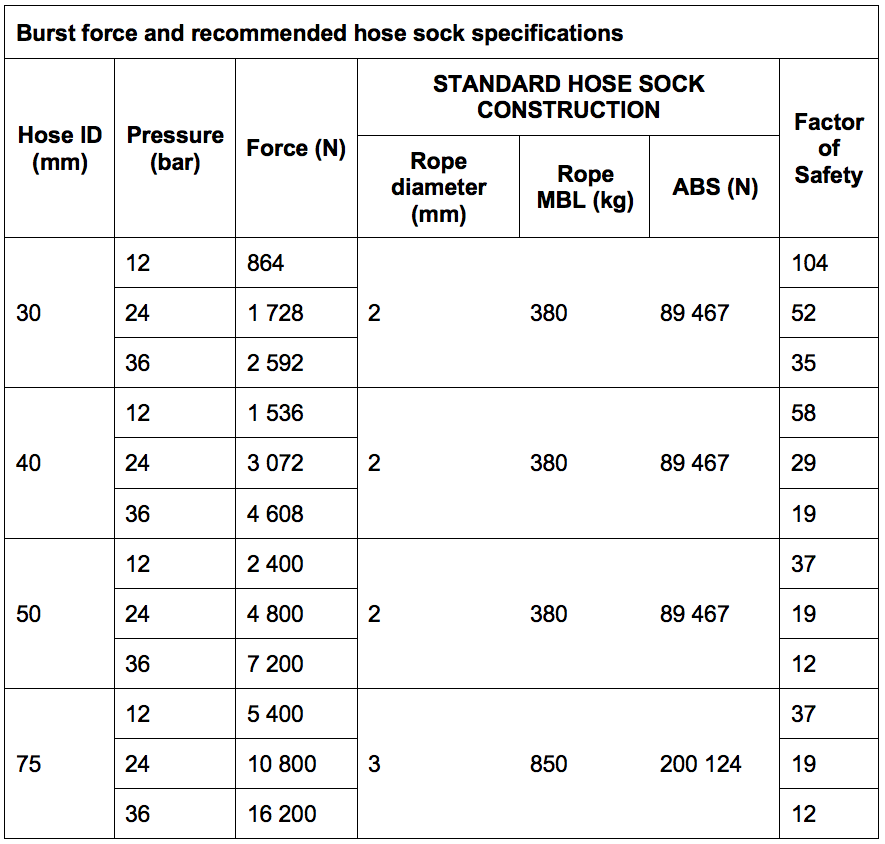Hose Sock Specifications
By Colin Rice of Colin Rice Exploration and Training (Pty) Ltd.
Banner photo supplied by Slings and Supplies
It is essential that the hose sock has sufficient strength to withstand the very large forces that are exerted when an air hose or fitting fails. Hose socks offer a very high level of protection - in this article I will illustrate the typical factors of safety that a well designed and constructed hose sock offers.
This is the second article of Part 2 of our Technical Series on Compressor and Air Hose Safety. Click here for an outline of the entire Compressor and Hose Safety Series.
Aggregate breaking strength
It is essential that the hose sock has sufficient strength to withstand the very large forces that are exerted when an air hose or fitting fails and so the restraint must be designed and constructed of wire rope of sufficient strength and it must be long enough that it will provide sufficient grip on the hose.
Although the hose sock type restraint has been proved to offer the greatest level of protection for air hoses, there are no recognised standards for their application and so suggested specifications are included in another article in this Series.
As discussed in an earlier article, a hose sock is constructed from a series of wire ropes wound either in pairs or in sets of three in a helical fashion as shown in the image below. The strength of a hose sock will therefore be a function of the strength of the wire rope used which in turn is a function of the cross-sectional area of the rope and the grade of wire used in the construction the rope.
Wire rope is tested by applying a tensile load to a sample of the rope until destruction and this is reported as the Mean Breaking Load (MBL), Proof Load or Ultimate Tensile Strength (UTS) – all of these terms are synonymous. We can therefore consider the strength of the hose sock to be the aggregate of the strengths of the individual ropes that make up the hose sock this is called the Aggregate Breaking Strength (ABS).
Typically, the hose sock will consist of 12 sets of wire ropes and so the total strength or Aggregate Breaking Strength of the hose sock will be the sum of the strengths of the individual wires in the construction.
Typical hose sock construction
A typical hose sock suitable for a 50 mm internal diameter air hose for example, would be manufactured from 12 pairs of wire rope of 2mm diameter. The wire rope used will be of a simple 1 x 19 construction and a medium grade 2mm wire rope of this type will have a Mean Breaking Load (MBL) of approximately 380kg and so the Aggregate Breaking Strength will be of the order of 9 100kg (89,5kN).
As shown in the previous article, "Forces exerted by a failed air hose", the force exerted by a burst 50mm air hose at 24 bar pressure would be approximately 4,8kN and so the hose sock has a factor of safety of approximately 19 at this pressure. At 36 bar pressure the factor of safety is 12 and at 65 bar pressure the factor of safety is 7 - the hose sock therefore provides a very high level of safety.
Grip length
A hose sock must have sufficient aggregate breaking strength and it must be long enough to provide adequate grip on the air hose. I am not aware of any standards that exist that will guide us in determining an appropriate grip length and so I have searched several sources and compiled a "consensus opinion". These recommendations are shown in the article on "Proposed standards for the application of hose restraints to high pressure air hoses on drill rigs."
The recommendations provided in the table above and the table in the article on "Proposed standards for the application of hose restraints to high pressure air hoses on drill rigs" are provided as a guide for selecting the correct hose restraint and are based on information obtained from a number of different manufacturers, suppliers and users of hose restraints. Each application should be evaluated on its own merit and the advice of an engineer should be sought if conditions are substantially different from those described.


